RNA 60th Anniversary – How To Write Romance – Setting!
17 May 2020
In honour of the RNAs 60th anniversary year, we have put together a special series of blog posts on various aspects of writing romance. These will feature advice and comments from some of our bestselling author members, who all have a wealth of experience and expertise. We hope these posts will be informative and interesting to both new and seasoned writers, but please feel free to add your own tips in the comments section below!
Each month we are highlighting a particular aspect of writing romance, and this month our bestselling authors tell us about the importance of settings and what inspires them:-
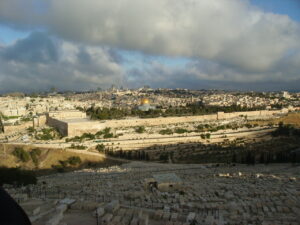
Jerusalem by Karen King
The setting is one of the starting points for Katie Fforde “so it’s very important to get it right.” She usually knows the physical location and adapts it, but “if I don’t know the location I either go there or spend a lot of time on YouTube.”
For Barbara Erskine, settings are “often the main inspiration for my books – that plus the background history.” Prue Leith agrees, but adds that “it has to be authentic”. She says “I’m too lazy to research new locations so I use what I know, setting most of my novels in the Cotswolds where I live. Also, in places I know, like Paris, London, Cape Town and India.” She takes lots of photos when abroad to remind her of certain things.
“Setting is … inspired by the story I want to tell and the emotions I want to elicit in the reader,” says Sarah Morgan. “It’s never random. It can influence mood, atmosphere, character and plot as well as reflecting theme … add tension … depth and layers to create an emotional effect that the reader probably won’t even notice (but will hopefully feel!).”
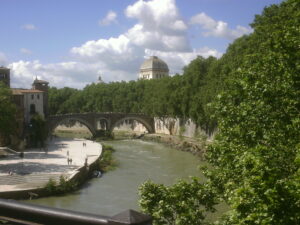
Rome by Karen King
The Mills & Boon Modern line, which Kate Walker writes for, is “the home of the sophisticated hero”, so glamorous international settings are “part of the promise to the reader”. Kate loves to “use the setting to put either the hero or heroine ‘on the wrong foot’ so that they’re out of their depth and unsettled in their surroundings”, for example by stranding a sheikh with her heroine in a Yorkshire snowstorm. “He is out of his comfort zone there, and so behaves differently to the way he would in his own desert home.”
Bath, Cornwall or the Cotswolds are Jill Mansell’s go-to settings. “I know them all well, but do prefer to make the towns or villages I write about fictional, otherwise people are apt to complain that I’ve made an appalling error in Chapter 43 because from the junction of those two particular roads it is, in fact, *not* possible to see the church spire.” She has now set three of her novels in St Carys in Cornwall – “after going to all the trouble of inventing an entire gorgeous little seaside town it seemed a shame not to return there. I’d drawn a detailed map and didn’t want to waste it!”
It’s the same for Milly Johnson – “I have whole villages and towns in my head.” They can be very important but not always. She’s “had books where the settings aren’t really that much of a feature and others where the setting is akin to a main character … We grow as fond of places as of people in books.” She adds that “settings are harder to write than people because … description can really slow a narrative down and make it boring.”
“Setting has always been important since I located my first book in a small safari camp in Kenya that I visited many times with my husband,” says Liz Fielding, but she doesn’t think they necessarily have to be exotic. “Gardens have served me very well.”
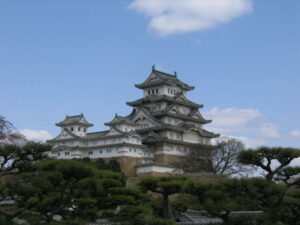
Himeji, Japan by Pia Fenton
Another author who starts with the setting is Dinah Jefferies. “It’s super important, especially as my first six books were all set in the Far East or the Indian subcontinent. I was born in Malaya and lived there as a child, so my inspiration came from that.” She’s written books set in many different countries and been to them all. “While there, I unearthed key details and learnt so much more than if I’d tried to acquire everything from books or films back home … It’s possible to write without going to a place but I would always choose to go.”
Sheila O’Flanagan also thinks travelling is “great for inspiring different thoughts and ideas … I like to bring my characters to different places.” Rosanna Ley is drawn to settings that she finds interesting – “whether it’s the sense of history, the stunning landscape, aspects of the culture, or the people that live there.” She believes a story might be “inspired by a place or a place might ‘fit’ the story/theme” she’s exploring. “Settings … create more layers of meaning and symbolism in a story and also provide mood and atmosphere.”
As she writes sagas set in the 1940s, Elaine Everest wants to ensure her readers “know they’ve stepped into a front room in a bomb-damaged house or a pub as the air raid sirens start to wail.” She visits museums, war and peace events, buildings, and even theme parks that have WW2 settings. “I will close my eyes, block out the modern world and imagine myself in the setting. When I can live the scene, I know that hopefully, I can write about it.”
How important is it to always go to your chosen location to see for yourself? Or if that is not possible, what do you do?
“Very important”, says Barbara Erskine. “One needs to be able to smell it and touch it. I love the small details … Can you really see the top of that mountain from there? Is there a loom of street lights here, or true dark skies?” She very seldom writes about somewhere she hasn’t been but “if I have to, I try and read … diaries, travel writing, even brochures! And there’s Google Earth! But that wouldn’t be a place central to the story. I would never start a story about somewhere I didn’t know.”

Balm Beach, Canada by Christina Koch
“Exotic settings are very popular with readers”, according to Kate Walker, but she doesn’t “do a lot of research or personal exploring … Some places I’ve visited, some I’ve researched online or in books, and some – like imaginary kingdoms or desert countries – I have created purely from imagination. The important thing is to remember that … you are not writing a travel guide with ‘places to visit’ listed in the book!”
If a novel is mainly set in a particular location, Sheila O’Flanagan would definitely have visited it “because you need to absorb the feeling of the place as well as its physical location and characteristics … However, if it’s a case of someone visiting a town very briefly, I’d Google Map it and look at it on Street View to get a sense of the geography.”
Jill Mansell would “make it up” if she can’t visit a place, and although Prue Leith prefers to write about places she knows well, “if I have to, I Google it of course!”
Whenever possible, Sarah Morgan tries to visit locations she writes about, “but sometimes deadlines and workload don’t allow it. Fortunately, these days it’s easy to access information on most places. People’s addiction to filming everything is great for writers.” She feels that “if you’re writing about a real place you need to make sure the details are correct, or you risk pulling a reader out of the story.”
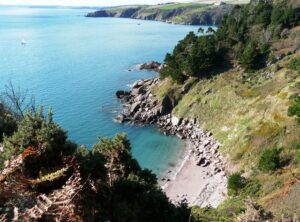
Devon cove by Pia Fenton
Rosanna Ley says “I always go there as no matter how much research you do, there is a certain flavour you can only capture by … seeing it for yourself. I walk the paths that my characters will walk and go to all the places they will go. I take lots of notes and photographs so that I can re-create it when I am back at my desk.”
“You can do a lot on the internet,” says Milly Johnson, “but videos won’t give you a true picture of the smells and atmosphere … in Norway for my latest I maybe wouldn’t have picked up that the snow is so different there had I not seen it for myself, powdery and dry. It wouldn’t have ruined the book had I not mentioned it … but details often help to really bring depth to a story.”
Liz Fielding finds it “helpful, obviously … but now I can look on YouTube and follow other people walking around.” However, “a trip is always welcome” and since her WIP is set in Paris in November, she took a long weekend in Paris!
For Elaine Everest, so much of the world she writes about has now gone. Instead, she immerses herself in old movies or “visit an air show when they feature Spitfires and Hurricanes re-enacting a battle, listen to music and dip into non-fiction books.”
If you write historical novels, how much description do you include in order to really immerse your reader in that period?
“I always try to do it by whatever means I can,” says Dinah Jefferies, “using all the senses, lots of historical detail, but also wholly credible settings.” She goes to “whichever country I’m using and, while there, I try to seek out as much of the past as I can. It isn’t always easy … some places have been very heavily modernised.”
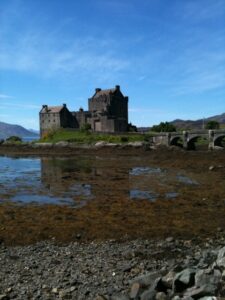
Eileen Donan by Pia Fenton
Barbara Erskine finds “it’s often more difficult to restrict myself in order to prevent putting in too much. A light touch is needed – enough to hint at period and atmosphere rather than pages of detail. I usually put in too much … and then have to cut.” Elaine Everest agrees. “I’ve always found it best to drip the details rather than stop the flow of the story to describe the setting and characters. Readers will see the scene themselves without us describing every little detail.”
Although Sheila O’Flanagan doesn’t write historical novels, she thinks that “regardless of the setting and era, you have to get things as accurate as possible, otherwise you open yourself up to a barrage of irate emails from readers putting you right.” Prue Leith also feels it’s important to “make very sure there are no anachronisms.”
“It’s all in the detail for me,” says Milly Johnson. “I don’t write historical novels but if I did, I’d add in things that would make a reader think they were really there in the belly of the story. Those little touches – like a pinch of spice in a dish – really do make all the difference.”
How about you? Any great tips you can share with us? We’d love to hear them!



